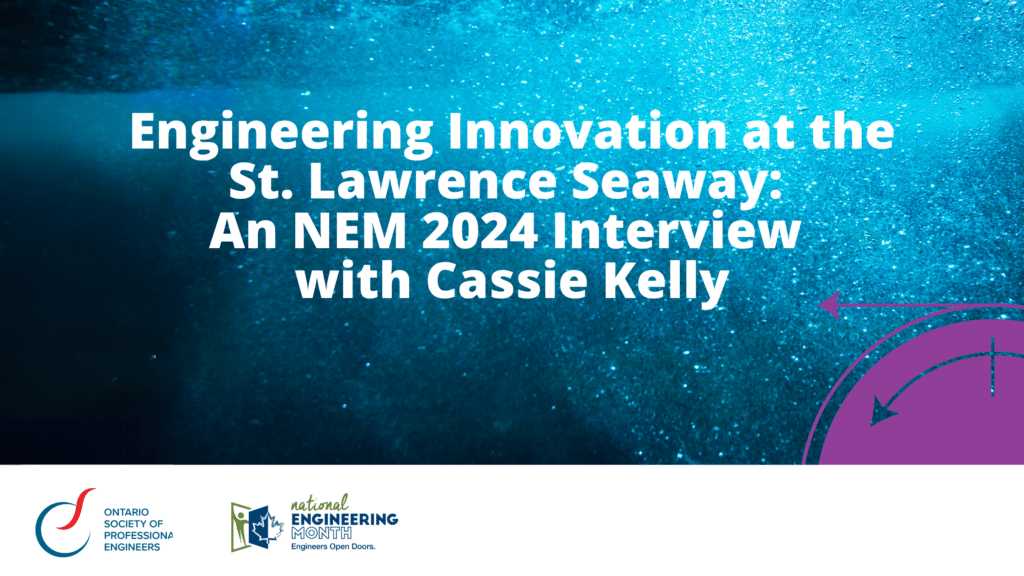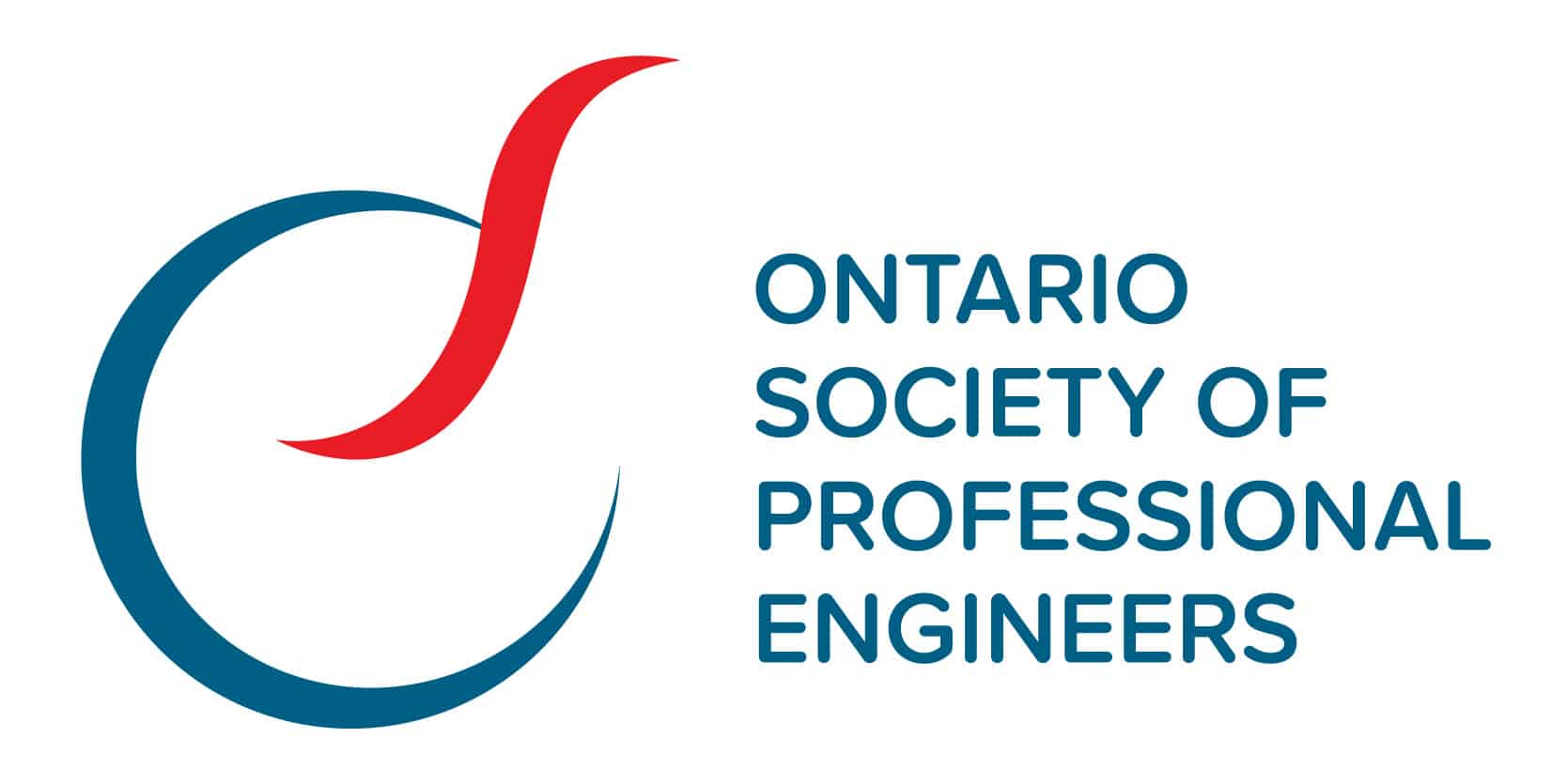
As we continue celebrating National Engineering Month (NEM) in Ontario, we are interviewing leaders within the province’s engineering community to highlight their contributions, insights, and experiences. These conversations celebrate the impact of engineering on our daily lives and inspire the next generation of engineers.
I recently met with Cassie Kelly, M.Eng, P.Eng, P.M.P., Manager, Engineering Niagara, St. Lawrence Seaway Management Corporation and Head of Engineering for the Welland Canal, to discuss some exciting projects currently underway.
Tell me about yourself:
I grew up in Montreal, and some of my favorite childhood memories are of Sunday drives with my father and siblings to the Côte Sainte-Catherine Lock on the Great Lakes-St. Lawrence Seaway. Even as a kid, I was fascinated by the Seaway—it’s an incredible feat of engineering. My father, who was also an engineer, would explain how this deep, narrow waterway allowed massive ocean freighters to travel from the Atlantic to the heart of North America through the Great Lakes.
I’ve had a varied career, starting in insurance and risk planning, where I visited countless plants over ten years, assessing installations and operations from a risk perspective. I’ve worked across industries, from the university sector to industrial transportation, and now at the St. Lawrence Seaway. I think that’s part of my message to younger engineers: engineering teaches you how to keep learning because nothing stays the same.
I’ve worked as a consulting engineer, project manager, contractor, and have taken on ownership roles in various projects. These diverse roles give me a unique perspective, and I bring a wide range of experience to any project. While I trained in civil engineering, I’ve worked across many disciplines, including mechanical, electrical, and environmental. My family has a long history of engineering—both my grandfathers were engineers, and I grew up in an environment where engineering was a constant conversation.
I’ve been working at the Seaway for over ten years now, and I currently lead a team of engineers, designers, and technical staff. We’re responsible for planning and executing projects involving large civil installations, mechanical equipment, bridges, locks, and the specialized infrastructure that makes the Seaway function. We operate in a unique environment with our own set of definitions and language—what we consider mechanical elements (since they move!) might be classified as structural or civil in other industries.
What excites you about your work?
The infrastructure itself is fascinating—it’s a significant part of Canadian history. But what really makes this job special is the combination of history and innovation. We’re operating a historic waterway using leading-edge technology, and it’s exciting to be part of that evolution.
Can you tell us more about the recent gates project?
One of our biggest recent projects was replacing the large mitre gates at Lock 7. Over the winter, during the holiday season, we undertook a major project to remove two gates from service and install two different, refurbished gates. Each gate weighed approximately one million pounds, presenting a significant engineering challenge just to move them!
Historically, when the canal was first built, engineers couldn’t lift that much weight as a single unit. Instead, they constructed the gates in place by lifting and assembling smaller components, using rivets rather than welding, which was not yet common practice. The differences in construction techniques and material capacities between then and now highlight just how much engineering has evolved over the years.
For our team, lifting and replacing these massive gates required meticulous planning and the use of specialized equipment. It took about five months of preparation to determine the best approach, coordinate logistics, and ensure that everything would go smoothly during the actual installation. The project was an incredible feat of engineering, showcasing our ability to balance historical infrastructure with modern technology and construction methods.
What inspires your team to make an impact through engineering?
Our team thrives on tackling unique challenges. Even when working on similar projects, no two situations are ever the same. Whether it’s maintaining aging infrastructure or finding innovative ways to improve efficiency, we are always learning and evolving. The mitre gate swap-out and the implementation of hands-free mooring are examples of how we are constantly pushing the boundaries of what’s possible.
As we incrementally extend our navigation season, we face an exciting challenge: rethinking our construction schedule to ensure essential work is completed within a shorter timeframe. This kind of problem-solving is what keeps our team engaged and motivated.
How does your organization support professional growth, development, and mentorship?
Continuous learning is crucial in engineering, and we strongly encourage our engineers to develop their skills. With Professional Engineers Ontario (PEO) now requiring ongoing professional development, we work with our team to identify training opportunities that align with our needs. We also bring in trainers for in-house workshops on topics such as safety, environmental regulations, and emerging technologies.
In addition to structured training, we emphasize mentorship. More experienced engineers help newer team members navigate complex projects, ensuring knowledge is passed down effectively. We also collaborate with external organizations, such as the U.S. Army Corps of Engineers, to share expertise and gain insights from other large-scale infrastructure projects.
What advice would you give to young people considering a career in engineering?
Engineering is one of the best professions you can choose. It teaches you how to learn, adapt, and solve problems—skills that will serve you for life. The beauty of engineering is that it offers endless possibilities. You can work in different industries, take on new challenges, and continually expand your expertise. If you stay curious and committed to learning, you will always have opportunities to grow and succeed.
I’ve worked in multiple sectors throughout my career, and each experience has been valuable. Engineering provides the foundation to explore various paths, and that flexibility is a huge advantage.
My advice? Embrace every challenge, stay open to new experiences, and never stop learning.
What excites you most about being a part of National Engineering Month?
National Engineering Month is a fantastic opportunity for engineers to share their passion for the profession. Engineers don’t always talk about the work we do, but this event gives us the chance to showcase the impact of engineering in our communities. It’s also a great way to connect with students and future engineers, helping them see the diverse career paths available in this field.
It’s exciting to engage with young people and encourage them to consider engineering. The world needs problem-solvers, innovators, and leaders, and engineering provides a way to make a real difference. Whether it’s designing infrastructure, developing sustainable solutions, or advancing new technologies, there’s something in engineering for everyone.
31 days. 31 Reasons to Get Involved in National Engineering Month.
National Engineering Month is your chance to connect, learn, and be inspired by the incredible work happening in Ontario’s engineering community. Attend events, engage with industry leaders, and discover how engineering shapes the world around us. Find an event near you and join the celebration.


